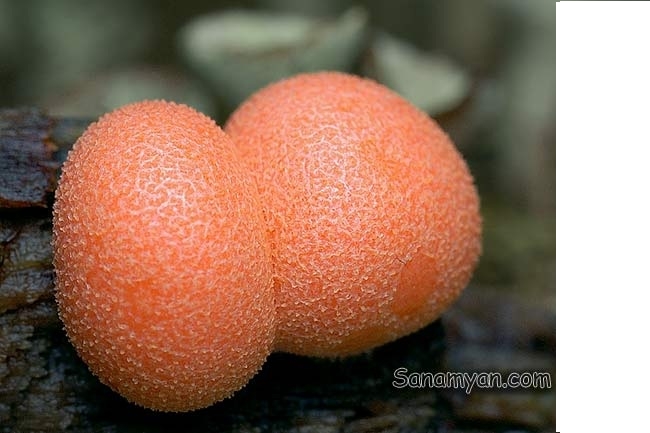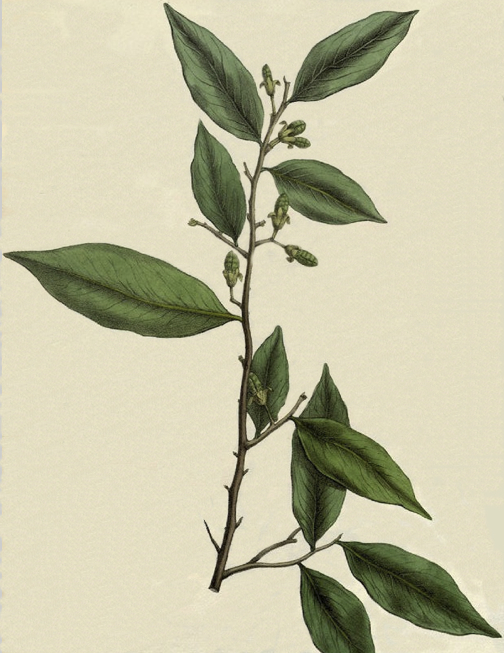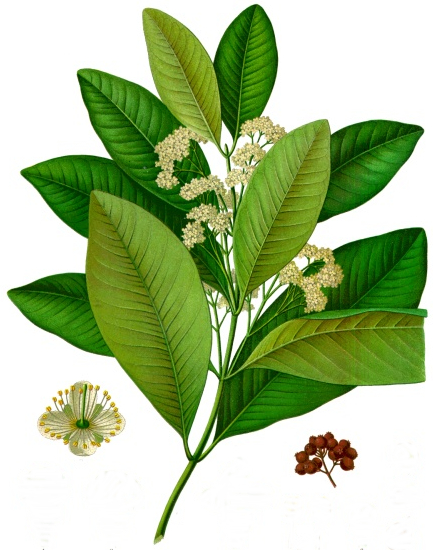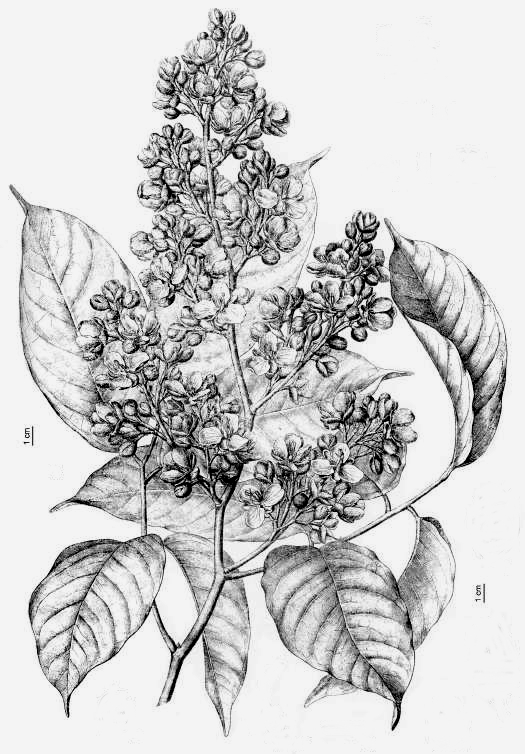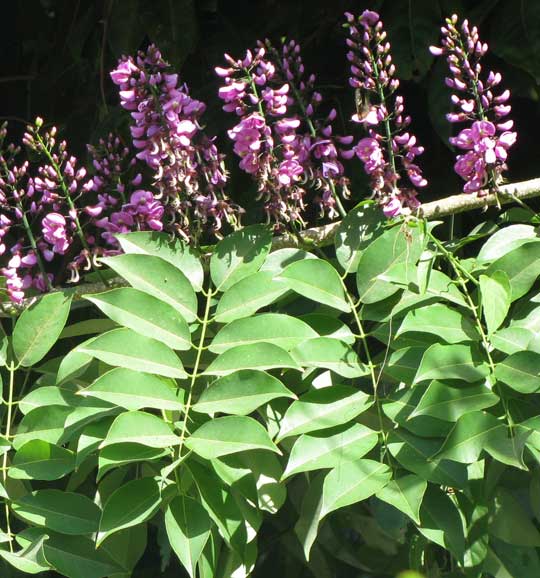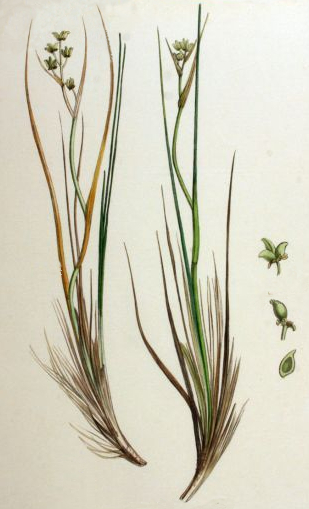ab·sin·the (ab´sin´thə) n. 1 wormwood. 2 an essential oil derived from absinthe, green in colour. 3 a liqueur prepared from this essential oil as well as perhaps other herbs, and tasting of licorice. It becomes cloudy when mixed with water. [ME < F < L absinthium < Gk. apsinthion αψίνθιον]
ac·crete (ə krēt´) v.i. of tissues or individuals, grow together or coalesce.
ac·cre·tion (ə krē´shən) n. 1 growth by organic enlargement. 2 a growing together of previously-distinct tissues or individuals. [< L accrētiōnem growth to, growth on] —ac·cre´tive, adj.
a·col·pate (ā´kōl´pāt) adj. of angiosperm pollen, lacking any evident colpi in their cell walls. [NL < Gk. a- α- not + LL colpus strike, hit]
ac·rit·arch (ak´ri tärk´) n. in palæontology, a microscopic portions of various classes of organism, which can be encountered in macerated sedimentary rock when searching for spores or pollen. b any of a proposed grouping of ancient marine eukaryotes, perhaps associated with the origin of dinoflagellates. [< NL Acritarcha Evitt < Gk. ákrit(os) άκριτος unarranged, undistinguishable + archḗ αρχή beginning] —ac´ri·tar´chous, adj.
a·cro·carp (ak´rō kärp´) n. a moss whose antheridium or archegonium is borne apically, rather than upon a lateral branch. [NL < Gk. akron άκρον the summit + karpos καρπος fruit] —a´cro·car´pic, adj. —a´cro·car´pous, adj.
a·cro·sco·pic (ak´rō sko´pik) adj. facing toward the apex. [< Gk. akros άκρος tip + skopein σκοπέιν look at + -ikos -ικος relating to]
ac·tin (ak´tin) n. a protein which is capable of providing motion to liquids and organelles within a living cell. [< Gk. aktinos ακτῑνος a ray, beam + NL -in chemical suffix for an activator]
ad·der·wort (ad´ər wôrt´) n. bistort; snakeweed.
adze (adz) n. a tool consisting of a steel blade presented crossways to an oblong wooden handle, which can be used to shape a felled tree – or large piece of wood – by creating a flattened surface. Adzes are frequently employed in boat-building. [< OE adesa]
ær·ate (ãr´āt) v.t. 1 add air, or access of air, to a substance (e.g. soil). 2 accomplish this by use of a metal implement which punctures the sod. [< L āer (< Gk. aēr αέρα air) + -ātum adjectival suffix] —ær·a´tion, n.
ær·a·tor (ãr´ā tər) n. 1 a metal implement which punctures the sod to allow access of air. 2 a device which introduces turbulence into flowing water to allow access of air. 3 a device which stirs grain stored in a granary, to allow access of air and prevent damage by fungus and insect.
ae·tha·li·um (e thä´lē üm) n. -li·a. a fruiting body comprising an aggregation of plasmodia, forming a spherical mass, and whose spore release appears like a puff of smoke. [< NL Aethalium (Pers.) Link, a former genus of divisio Myxomycota < Gk. aithalē αιθάλη smoke, soot + L -ium formation] —ae·tha´li·oid, adj.
aff. Abbrev. akin to, often used prior to an existing Linnaean binomial, in the case where a provisional taxon appears to have no correct existing name, but resembles the species indicated. [< L affinis neighbouring, related, akin]
a·gal·loch (ə gal´ok) n. fragrant, resinous heartwood from a Burmese tree (Aquilaria agallocha Roxb., of the Thymelaeaceae); agarwood; agilawood. [< LL agallochon < Gk. agállochon αγάλλοχον < Dravidian]
a·gar·wood (ä´gär wu̇d´) n. the dark resinous heartwood of certain species of the genera Aquilaria Lam., Gyrinops Gaertn., and especially Lachnolepis moluccana Miq. (all of the Thymelaeaceae), which forms in response to infection by an ascomycete; oud. It is highly valued as a fragrance.
ag·glu·ti·nate (ə glü´ti nāt´) v. become, or cause to become, firmly stuck together in a mass or clump. [< L agglutino fasten with glue] —ag·glu´ti·na´tion, n.
a·gi·la·wood (ä gē´lə wu̇d´) n. agalloch. [< Pg. aguila eagle + E wood]
ag·let (ag´lit) n. 1 a catkin of the hazel. 2 an anther of hazel. [ME < MF aiguillette diminutive needle]
air layer v.t. air layered, air layering. the inducement of new roots in a shrub or tree, by cutting an incision in the bark above ground and packing the exposed tissue with soil or peat to encourage development of roots. The altered branch can then be removed and planted elsewhere.
ait (āt) n. a small island, especially in a river; eyot. [ME < OE ȳgett, igeoð dim. of ieg island, cf. Sw. ö, ON ey]
aj·o·wan (ä´djō wän´) n. 1 ammi. 2 any of various related species of the genera Trachyspermum Link, Sison L., and Carum L. (all of the Apiaceae), and native to ranges in Africa, the middle east, and central Asia; carom. All produce fruits bearing oils rich in thymol, and are of use in medicine and as spice. [< Hindi ajvāyn]
al·biz·i·a or al·biz·zi·a (al bit´sē ə) n. any of a number of species of pantropical shrubs or trees correctly-attributed to genus Albizia Durazz. (of the Fabaceae: Mimosoideae), bearing pinnate or bipinnate leaves and featuring flowers with numerous elongate monadelphous stamens; silk tree. [< Filippo degli Albizzi (18th c. Florentine naturalist) who introduced tree to Italy]
a·leur·o·man·cy (ə lür´ə man´sē) n. Obs. the practice of divination using flour. [< F aleuromancie < Gk. aleuromanteîon ἀλευρομαντεῖον < aleuron ἄλευρον wheaten flour + manteía μαντεία divination] —a·leur´o·man´tist, n.
alley cropping n. a method of establishing sustainable agriculture in an area of tropical forest which has previously sustained slash and burn exploitation. It consists of planting alleys of beneficial tree species (often, species of Inga Mill., of the Fabaceae: Mimosoideae) in rows at approximately 4m intervals, and growing crops in the soil between the rows.
al·loch·tho·nous (ə läk´thə nəs) adj. in the interpretation of fossils, specimens found in a place other than where they were naturally found living and growing. [< Gk. allokhthon ἄλλοχθών < allos ἄλλος another, different, strange + khthonos χθονός earth, soil]
al·lo·ge·ne·ic (al´ə je nā´ik or -nē´ik) adj. in phytogenetics, of or pertaining to tissue which is genetically dissimilar, although originating from the same species; allogenic. [NL < Gk. allos ἄλλος another, different, strange + geneos γένεος race, kind + -ikos -ικος relating to]
al·lo·gen·ic (al´ə jen´ik) adj. 1 of community succession, caused by environmental change beyond the control of component species. 2 allogeneic. [NL < Gk. allos ἄλλος another, different, strange + NL -genic giving rise to, originating]
all·spice (äl´spīs) n. 1 an aromatic berry whose ground seeds, or the fruit in its entirety, are the source of a spice. 2 the tree upon which these fruits are borne (Pimenta dioica (L.) Merr., of the Myrtaceae), native principally to Jamaica. One variety (P. dioica (L.) Merr. var. tabasco (Schltdl. & Cham.) Standl.) is often used in Tabasco. [named for its apparent combination of flavours from cinnamon, nutmeg, and cloves]
alpha diversity n. the species diversity of a particular biocœnosis. [< Gk. α alpha, first letter + E diversity]
al·phit·o·man·cy (al fit´ə man´sē) n. Obs. the practice of divination using barley meal, or else loaves of barley. [< Gk. álphiton ἄλφῐτον barley + manteía μαντεία divination] —al·phit´o·man´tist, n.
al·um·root (al´əm rüt´) n. 1 any member of the North American herbaceous genus Heuchera L., especially H. americana L. and H. parvifolia Nutt. ex Torr. & A.Gray (of the Saxifragaceae). 2 the root of such a plant, used medicinally as an astringent. [< ME alum {< OF < L alūmen potassium alum K₂SO₄⋅Al₂(SO₄)₃⋅24H₂O} + OE rōt root]
al·var (äl´vär) n. adj. —n. a naturally open habitat upon limestone or dolomite bedrock, comprising a grassland or dwarf shrubland upon thin and scattered soil deposits. —adj. 1 conforming to an alvar community. 2 pertaining to an alvar community. [< Sw. alvaret vegetated limestone pavement]
am·la (äm´lä) n. a small tree native to the east Indies (Phyllanthus emblica L., of the Euphorbiaceae), bearing edible berries which are sour and astringent. The plant has been used for a wide variety of medicinal purposes, with particular effectiveness against pancreatitis. [< Sanskrit amalaki]
am·mi (ä´mē) n. an African species (Sison ammi L., of the Apiaceae), bearing fruits whose oil is rich in thymol, and is of use in medicine and as a spice; ajowan; carom. [Gk. ἄμμι]
am·phi·tro·pous (am´fē trō´pəs or am´fit´ rə pəs) adj. of an ovule, being partially inverted shortly after its development begins so that its micropyle is situated to one side funiculus attaches to the carpel or ovary. The radicle of the ovule remains near the attachment of the funiculus to the ovule, and it is the funiculus which is bent through approximately 90°. [< Gk. amphi ἀμφί around + tropos τρόπος turn, change in manner] —am´phi·tro´pic, adj.
a·na·tro·pous (an´ə trō´pəs or ə nat´ rə pəs) adj. of an ovule, being completely inverted shortly after its development begins so that its micropyle is situated near the place where the funiculus attaches to the carpel or ovary. The radicle of the ovule remains near the attachment of the funiculus to the ovule, and it is the funiculus which is bent through 180°. [< Gk. ana ἄνα without + tropos τρόπος turn, change in manner] —a´na·tro´pic, adj.
anchovy pear n. the fruit of a tree native to the West Indies (Grias cauliflora L., of the Lecythidaceae), which bears fleshy capsules containing several large woody seeds, often used as a source of oil; river pear.
an·dro·di·œ·cious (an´dro dī ē´shəs) adj. an expression of sexuality in which some plants of a species bear hermaphrodite flowers, while others of the same species bear only male flowers. [NL < Gk. anēr, andros ἀνήρ, ἀνδρός man + dis δίς two, double + oikiā οἰκία dwelling + OF -ous (< L -osus prone to)] —an´dro·di·œ´cious·ly, adv. —an´dro·di·œ´cism, n.
an·droid (an´droid´) adj. of petals, retaining or exhibiting features of stamens or staminodia. [< NL < Gk. andros ἀνδρός male + L -oides, a contraction of Gk. -eidos -εἶδος a thing that is like]
an·ge·li·que (än´dje lē´ke) n. 1 a hard reddish wood very suitable for shipbuilding due to its durability. 2 the trees which produce this wood (Dicorynia paraensis Benth., as well as the closely-related D. guianensis Amshoff, both of the Fabaceae: Caesalpinioideae), native to Brazil and the Guianas. 3 Rare. angelica. [< F angelique angelica]
an·gi·o·car·pous (an´djē ō kär´pəs) adj. 1 of a fruit, being borne partially or wholly enclosed by a receptacle or husk. 2 of a fungus or lichen, having the reproductive structures embedded in or enclosed in the thallus. [< Gk. angeion αγγεῖον vessel + karpos καρπος fruit + -ōsus -ωσις prone to] —an´gi·o·car´pic, adj.
an·ther·o·zo·id (an´thər ə zō´id) n. a mature male sex cell, found in certain algæ, bryophytes, and gymnosperms, which is motile; spermatozoid. [NL < Gk. anthēra ἀνθηρά anther + -zoid -ζωΐδιον animalcule (< zōon ζῶον animal + -idion -ΐδιον diminutive)]
an·ti·cli·nal (an´tē klī´nəl) adj. 1 of the plane of cellular division, oriented perpendicular to the surface of an organ (such as the meristem), so that additional cells are produced laterally. 2 of a cell wall, oriented perpendicular to the surface of an organ as a result of such growth. [< Gk. antí ἀντί against, opposite of + klinein κλίνειν lean] —an´ti·cli´nal·ly, adv.
a·pet·al·ous (ā´pet´əl əs) adj. of a taxon or its flowers, bearing no petals. [< Gk. a- α- absence + petalon πέταλον flower leaf] + -ōsus -ωσις prone to]
a·pet·al·y (ā´pet´ə lē) n. the character state of neither generating nor possessing petals; being apetalous. [< Gk. a- α- absence + petalon πέταλον leaf + E -y abstract noun suffix]
a·phan·i·sis (ə fen´i sis) n. in botany, an evolutionary tendency toward reduction in number of perianth parts; perianth reduction. [Gk. aphánisis ἀφάνισις disappearance]
ap·he·li·o·tro·pism (ap´hē lē ō trōp´iz əm or ap´hē lē ot´rə piz´əm) n. an involuntary response to the sun’s rays; a tendency that makes a plant turn or move away from the light; negative heliotropism. [< Gk. apo- ἀπό- from, away from + hēlios ἥλιος the sun + tropē τροπή a turning + -ismos -ισμος a state or condition] —ap´he·li·o·tro´pic, adj. —ap´he·li·o·tro´pi·cal·ly, adv.
a·phyl·lous (ə fil´əs or ā fil´əs) adj. of a living plant, being naturally leafless. [< NL aphyllus < Gk. áphyllos ἄφυλλος < an- ἄν- without + phyllon φύλλον leaf] —a·phyl´ly, n.
a·pic·u·lus (ə pik´yu̇ lüs´) n. -u·li (-yu̇ lē´). of a stem or leaf tip, a short, distinct tip. [NL < L apex, apicis apex + -ātus provided with]
ap·o·chla·myd·e·ous (ap´ō kHlə mid´ē əs) adj. pertaining to or having the sepals and petals of an inflorescence distinct from the androecium and/or gynoecium. [< Gk. apo- ἀπό- away from + chlamydos χλαμύδος cloak, mantle + L -eus similarity]
ap·o·ge·o·tro·pism (ap´ō jē´ō trō´piz əm) n. movement of roots and shoots of organisms upwards; negative geotropism. [NL < Gk. apo- ἀπό- away from + gē γῆ earth + tropē τροπῇ a turning + -ismos -ισμος state or condition] —ap´o·ge´o·tro´pic, adj. —ap´o·ge´o·trop´i·cal·ly, adv.
ap·o·pet·al·ous (ap´ō pet´əl əs) adj. of a taxon or its flowers, having the petals tending to be reduced in number as an evolutionary trend; secondary apetaly. [< Gk. apo- ἀπό- from, away from + petalon πέταλον flower leaf + -ōsus -ωσις prone to] —ap´o·pet´al·y, n.
ap·o·ste·mo·nous (ap´ə ste´mə nəs) adj. of a taxon or its flowers, producing separate, distinct stamens. [< Gk. apo- ἀπό- from, away from + stemōn στήμων thread, stamen + L -ōsus pertaining to, prone to]
ap·pend·age (ə pen´dədj) n. 1 a projecting organ of an individual; branch; enation; process. 2 any subsidiary organ which is superadded to another. [ME, < append]
apple-leaf n. a tree native to southern and central Africa (Lonchocarpus violaceus Oliv., of the Fabaceae: Papilionoideae), bearing imparipinnate leaves whose pinnæ resemble leaves of apples, racemes of vivid purple flowers, and a single-seeded legume as fruit.
ap·po·si·tion (ap´ə zi´shən) n. 1 growth of a cell by means of deposition of additional wall material around existing cell wall components; intussusception. 2 assimilation of new substances into the existing components of living tissue. 3 the act of placing adjacent, juxtaposition. [< ME apposicioun < LL appositiōnis comparing, juxtaposing]
ap·pres·so·ri·um (a´pre sōr´ē üm or -ē əm) n. -ri·a. a structure formed at the tip of infectious or mycorrhizal mycelia which come into contact with a host plant surface. It consists of a flattened cytoplasmic pad which settles upon the tissue surface (attracted by chemical cues), and a penetration peg which penetrates the cuticle and cell walls of the host plant. [NL < L appressus press upon, clench + -or agent + NL -ium locative suffix]
ar·bor·ist (är´bə rist´) n. one who is a specialist in the growth and care of trees, including treatment of nutritional deficits and infestations. [< F arboriste]
ar·bus·cle (är bus´kəl) n. 1 a dwarf tree, one between a shrub and tree in size, as a penjing. 2 a growth form of endomycorrhizæ, where – once a mycelium enters a plant cell – it forms a short-lived branching outgrowth within that cell. [< L arbuscula small tree] —ar·bus´cu·lar, adj.
ar·il·lo·car·pi·um (är´i lō kär´pē üm) n. -pi·a. a modified megastrobilus which is characteristic of the taxads, bearing a seed subtended by a fleshy arillate bract. [< NL arillus aril + carpium (< Gk. karpion κάρπιον < karpos καρπος fruit)]
ar·row·grass (ãr´ō gras´) n. 1 any member of the genus Scheuchzeria L. (of the Scheuchzeriaceae), which grows in peat bogs of the northern hemisphere. It is a low herb whose leaves are linear and sheathing, and whose flowers bear 2 whorls of tepals, 2 whorls of stamens, and 2 whorls of 3 free carpels. 2 any of a number of species of the genus Triglochin L. (of the Juncaginaceae), upright graminoid semiaquatic perennial herbs frequent in marshes worldwide. [descriptive of the open capsule segments of T. palustris L.]
as·cend·ent (ə sen´dənt) adj. directed or growing outwards and then curving upwards; ascending. [ME < L ascendens climb up, rise]
as·pect (as´pekt) n. 1 the appearance or quality of an individual organism or community, at a particular time. 2 the direction towards which a sloping substrate faces. 3 the specific way in which an object or mental construction is considered. [ME < L aspectus appearance, visible form] —as·pec´tu·al, adj.
as·per·ate (as´pėr āt´) v.i. of tracheid pits, close with age. [< L asperātus, pp. of asperāre make rough]
auct. (auc tō´rüm) Abbrev.n. author, or authors, used in Linnaean nomenclature for an unspecified author or authors subsequent to the recognized authority, who has or have misapplied the preceding name. Occasionally, such an abbreviation used in place of the recognized authority will be followed by Latin non (not) and the recognized authority. [L auctorum of author(s)]
auct.mult. (auc tō´rüm mül tō´rüm) Abbrev.n. multiple authors, used in place of an authority in Linnaean nomenclature, specifically in the case where the preceding name has been previously misapplied in several distinct contexts by several authors. [L auctorum of author(s) + multorum many]
aut·o·e·cious (ot´ō ē´shəs) adj. a term used of parasitic rust fungi which produce all of their sporulation upon a single plant species. [NL < Gk. autos αὐτός self + oikiā οικία dwelling + L -osus prone to] —aut´o·e´cism, n.
au·to·gen·ic (o´tə jen´ik) adj. of community succession, caused by environmental change originating in actions of component species. [NL < Gk. autos αὐτός self + NL -genic giving rise to, originating]
au·to·ly·sin (o´tə lī´sin or o´täl´i sin) n. any of a chemical group of enzymes which are capable of destroying the cell walls or tissues of an organism within which they are produced. [< G autolysis + NL -ina noun suffix denoting organic substances or compounds]
au·tol·y·sis (o´täl´i sis) n. -ses. the destruction of cells or tissues through application of enzymes produced within the tissues involved. [< G < Gk. autos αὐτός self + lysis λύσις loosing, release] —au´to ly´tic, adj.
aux·in (ok´sin) n. a plant hormone which promotes elongation of cells in principle axes such as roots and shoots, and also augments growth events in buds as well as playing a rôle in dehiscence. [< G < Gk. auxē αὔξη growth, increase + NL -ina noun suffix denoting organic substances or compounds] —aux´in·ic, adj.
aux·o·troph (ok´sə trōf´) n. a mutant microorganism which has distinct nutritional requirements from those of the parent strain. [< Gk. auxē αὔξη growth, increase + trophos τροφός one who feeds] —aux´o·tro´phic, adj.
axe (aks) n. a tool consisting of a steel blade parallel to – but presented at right angles to – an oblong wooden handle, which can be used to cut down a tree by chopping through its trunk. [OE æx < Gmc.]

